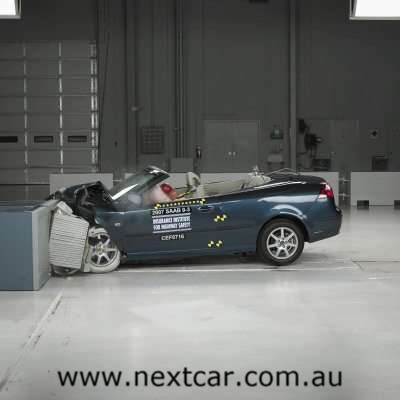|
| |||||
|
Saab 9-3 Convertible Receives Top Crash Test Honours from IIHS
5th June, 2007 | ||||
|
The Saab 9-3 Convertible has earned the 2007 Top Safety Pick award for open-top models in crash tests conducted by the U.S. Insurance Institute for Highway Safety. The 9-3 Convertible joins the 9-3 Sport Sedan, which has received top honours three-years running, in receiving this top IIHS accolade. To qualify for ‘Top Safety Pick’ award, a maximum ‘good’ rating must be recorded in each of three demanding tests involving frontal and side impacts and an evaluation of seat/head restraint protection in a simulated rear-end impact. The vehicle must also offer electronic stability control and convertibles must be equipped with roll bars. “We are delighted that these IIHS findings confirm our own crash test results,” says Per Lenhoff, head of Safety at Saab Automobile AB in Sweden. “This reassures consumers that the 9-3 Convertible is among the very best in its class for crash safety.” As part of its on-going work with crash safety, Saab has led the automotive industry in pioneering the development of active head restraints to help prevent neck injury in rear-end impacts. Saab Active Head Restraints (SAHR) are standard equipment to the front seats of all its current car models. The 9-3 Convertible is also equipped with Saab Dynacage, which includes pop-up roll bars to help provide protection in the event of a roll-over crash or an impact that could lead to a roll-over. The IIHS frontal crash test assesses structural performance and potential injury to the driver dummy in a 40 mph (64 km/h) impact against a fixed deformable barrier with a 40 percent overlap on the driver’s side. For the side impact test, a deformable barrier simulating an SUV or light truck is propelled against a stationary vehicle at 31 mph (50 km/h) on the driver’s side. Structural performance and potential injuries to a dummy at the wheel and another seated immediately behind are assessed. In the dynamic seat and head restraint test, a seated dummy is mounted on a sled which is accelerated to 10 mph (16 km/h) and stopped within 0.1 seconds, simulating the effect of a 20 mph (32 km/h) rear-end impact. The test is designed to assess protection against neck injury. | |||||
ABN 47106248033 |
 |
All rights reserved. |
